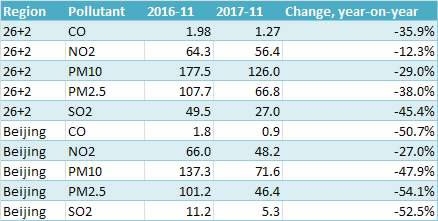
Tech & Sci
14:30, 13-Dec-2017
China witnesses historic drop in air pollution
Alok Gupta

China may be notorious for choking air pollution but this winter the country is witnessing a historic drop in pollutant concentration levels.
A high-level of extremely fine particulate matter (PM) measuring 2.5 and 10 microns in size; sulfur dioxide, nitrogen dioxide and carbon monoxide in the atmosphere leads to air pollution.
Air quality in Beijing is noticing a significant drop in PM2.5 by 54 percent, the highest reductions in the recorded winter. PM2.5 are known to enter the bloodstream and lungs, leading to fatal diseases.
Last year, PM2.5 levels hovered at 108 micrograms, nearly double this year’s level of 67.4 micrograms, a Greenpeace study said.
Sulfur dioxide presence in the city’s air also reduced by 52.5 percent compared to the previous year's emissions. Sulfur dioxide is a significant contributor to the formation of PM2.5 particles.
PM10 levels are also seeing a drastic drop from 137 micrograms last year to nearly 71.6 micrograms this winter, a reduction of 41.7 percent.
Shifting from coal to green energy
Lauri Myllyvirta, air pollution specialist at Greenpeace Beijing told CGTN that the massive drop in air pollution is the result of a major shut down of cement and steel plants, plus restrictions on small-scale coal use.
“Steel output is restricted at plants representing 25 percent of capacity at the national level, and cement production has been stopped during the entire heating period,” he said.

Pollutant levels in the air has drastically reduced this winter in the Beijing-region. /Greenpeace graphic
Pollutant levels in the air has drastically reduced this winter in the Beijing-region. /Greenpeace graphic
The shift from coal to gas coupled with a tight control on polluting industries is seen as a major reason behind smog-free winter days.
“It’s not only Beijing, but air pollution has come down in the entire region,” he added.
China’s Ministry of Environmental Protection (MEP) released a detailed action plan this year to curb air pollution in 26 other cities in Hebei, Shandong, Henan and Shanxi provinces.
A separate target was set for two cities – Beijing and Tianjin – under the 26+2 plan. A national goal was set to reduce PM2.5 level by at least 15 percent year-on-year in these 28 cities from October to March to achieve ambient air quality.
The Greenpeace report further reveals that in November this year, PM2.5 in the entire 28 cities in the Beijing region reduced by 37 percent and hovered at 67 micrograms.
In the same period, last year, PM2.5 level was 108 micrograms. Sulfur dioxide levels in the region saw a decline of 45.4 percent.
China had implemented an elaborate coal to gas plan for heating that starts from mid-November and ends in mid-March. Experts claim that plan has also helped curb pollution levels.
The government targeted 10 million households for a switchover from coal to gas for heating and cooking.
While a shift from coal to gas in winter months is working efficiently, there are reports from various regions facing a gas shortage for heating. The government has allowed the use of coal, in case gas supplies run out.
In an attempt to ensure smog-free days this winter, MEP had intensified inspections of polluting and monitoring air quality from April onward.
A 25-round inspection was planned for yearlong monitoring of emissions from industrial units in the region.
“A total of 5,600 inspectors have been deployed targeting Beijing, Tianjin, and 26 cities in the Beijing-Tianjin-Hebei and surrounding area to control air pollution,” an MEP press release said.

SITEMAP
Copyright © 2018 CGTN. Beijing ICP prepared NO.16065310-3
Copyright © 2018 CGTN. Beijing ICP prepared NO.16065310-3